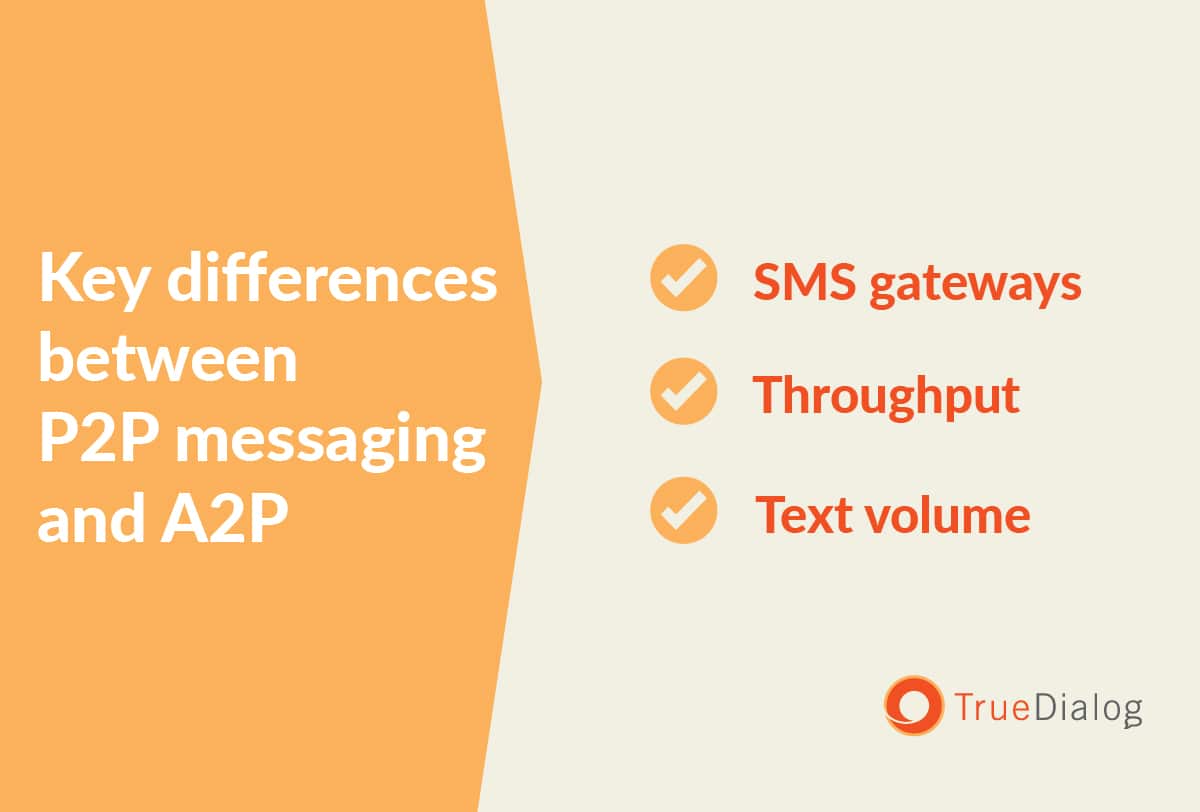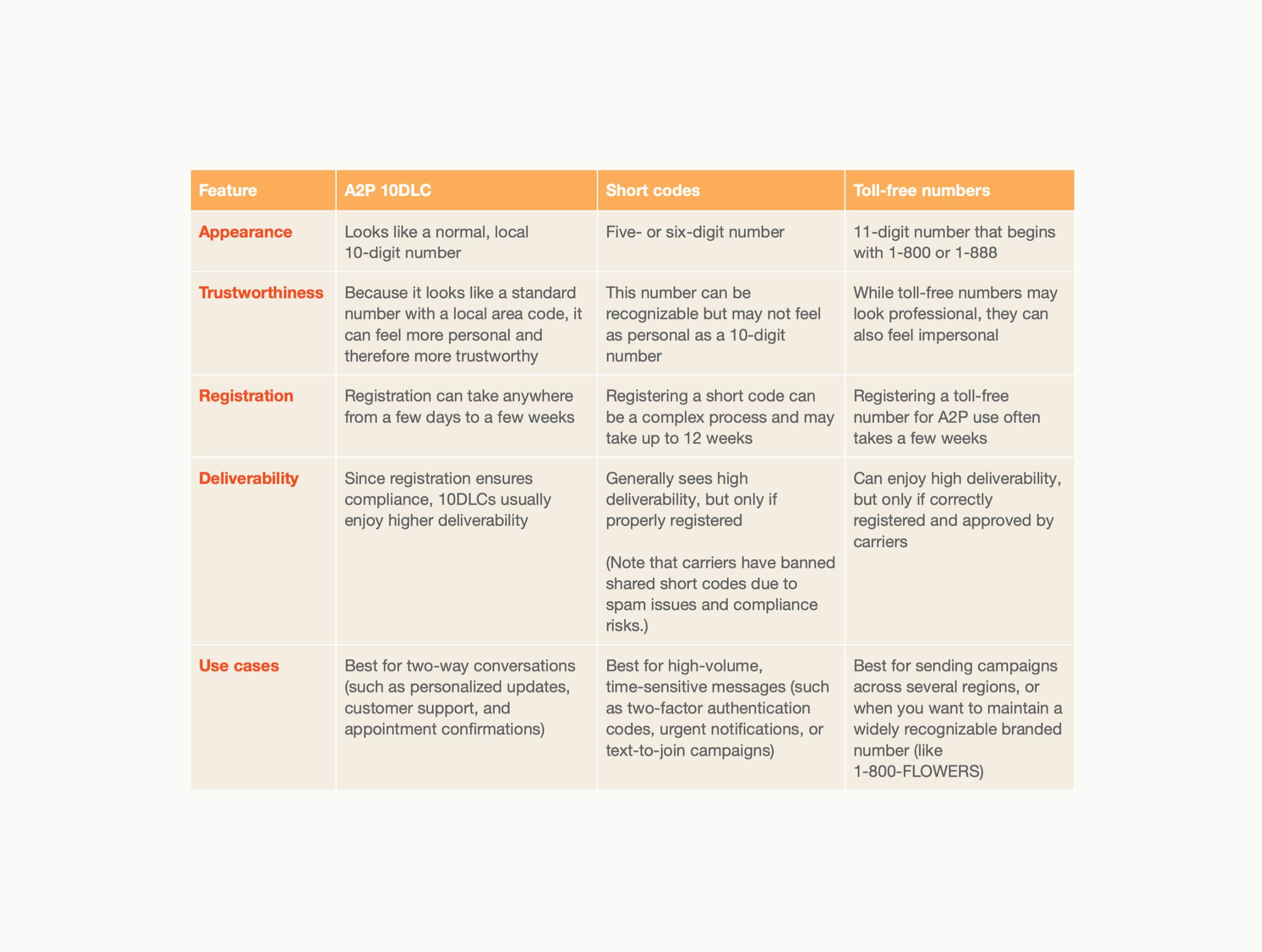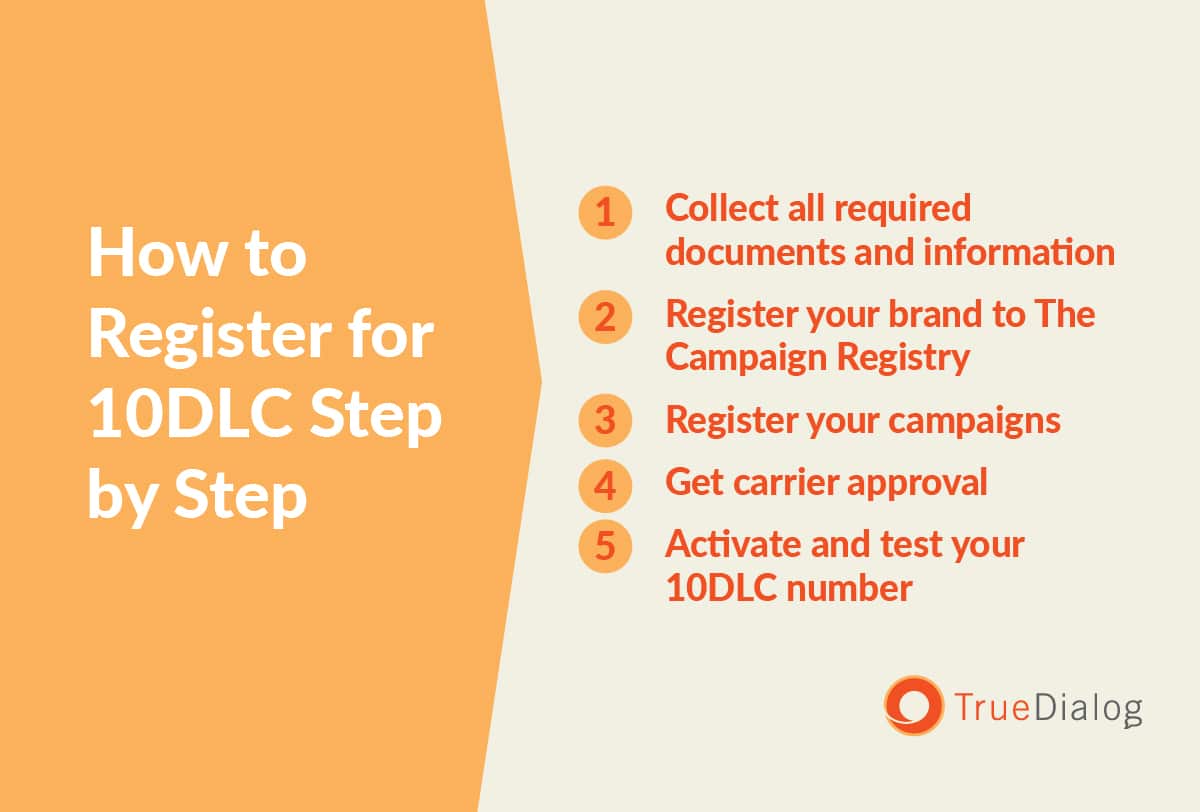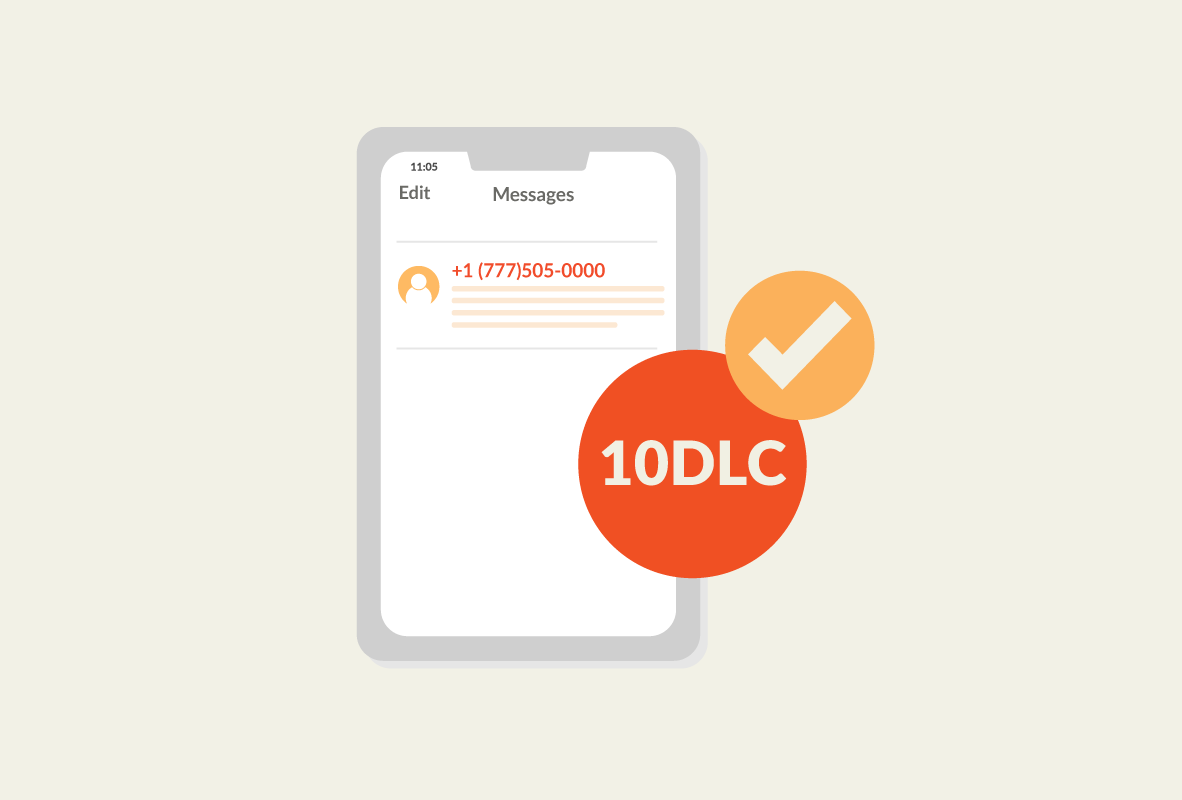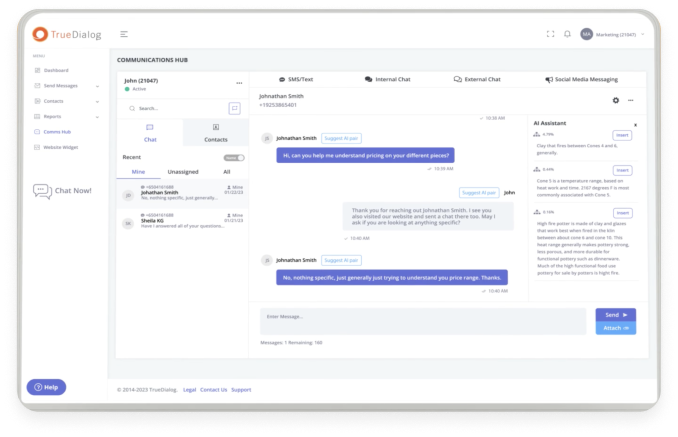Complete Guide to A2P Messaging and 10DLC
As a marketer, entering the world of enterprise SMS can seem overwhelming. To succeed with this channel, you have to master new technology, develop a comprehensive strategy, and keep up with a multitude of ever-evolving regulations. It’s a lot to manage — so, if you’ve recently found yourself frantically Googling, “What is A2P messaging?” or “How to register 10DLC,” then know you’re not alone.
The good news is that, although it can be intimidating to wade through a bunch of new jargon and acronyms, it’s a lot simpler than you expect. In this guide, we’ll demystify some of these foundational concepts so you can stop stressing and send text campaigns with ease.
What Is A2P Messaging?
Application-to-person (A2P) messaging is a type of messaging in which one party uses a special kind of software (called a mass texting service) to send a text to a subscriber’s device, rather than texting from one phone to another. This process allows businesses, schools, financial institutions, and other organizations to send messages reliably and securely — and helps them easily organize and respond to incoming messages as well.
A2P Meaning and Purpose
When most people ask, “What is A2P messaging?” they’re not only curious about what the term means, but also why it’s relevant to their business. In short, using this type of messaging supports compliance and convenience.
For most of us, managing even a handful of simultaneous conversations on our personal devices can be exhausting. When you imagine multiplying that process by hundreds, thousands, or even millions of contacts, you can see how the standard phone-to-phone texting process would quickly become impossible for a brand. A2P messaging solves this problem by enabling marketers to send messages at scale.
Of course, messaging your audience via phone-to-phone methods isn’t just inefficient — it’s also now prohibited by carriers and likely to get your messages filtered and blocked. But A2P has built-in processes to vet brands and campaigns, helping reduce SMS spam and ensuring businesses meet compliance requirements.
A2P vs. P2P Messaging
When people text each other, they use peer-to-peer (P2P) messaging — which is the standard, phone-to-phone text communication most of us engage in every day.
There are a few key differences between P2P messaging and A2P:
- SMS gateways
One of the biggest differences between A2P and P2P messaging is that, when a message is sent from a business messaging platform, it passes through an SMS gateway before reaching the carrier network. This gateway serves as a bridge between the application and the carrier, converting messages into the correct formats and ensuring that large-volume sends can reach recipients in a timely manner. - Throughput
Another core difference is throughput (i.e., the number of messages that can be sent and received within a given time period). P2P messaging has a throughput of about 15 to 60 messages per minute, while A2P messaging allows for a higher volume. (The exact amount varies based on carrier requirements and the texting solution you choose, but it’s usually thousands per minute.) - Text volume
Even with an “unlimited” texting plan, many carriers impose caps on senders to help reduce spam. For P2P, the maximum number of texts allowed per day is usually in the thousands (which is significantly more than the average person sends or receives in a day). However, the limit for A2P is generally much more generous to account for organizations with large audiences. In fact, if you’re following compliance requirements and using a solution like TrueDialog that has direct carrier connections, it’s unlikely that you’ll face carrier limits.
What Is 10DLC and Why Was It Introduced?
Giving a brand permission to text you is a little bit like giving someone a key to your home — it’s a choice you make while trusting the other party won’t barge in unannounced, inundate your space with junk, or leave the door open to intruders. As a marketer, you understand the importance of respecting your audience’s text inbox, but as you might’ve noticed from the increasing volume of spam messaging, not everyone cares about etiquette.
Fortunately, over the past few years, carriers have been cracking down on this issue more than ever. In an effort to curb spam texts and help ensure that legitimate businesses can more easily reach their audiences, they launched A2P 10-digit long code messaging (10DLC).
Understanding 10DLC and how it differs from other types of numbers is vital to making sure your SMS marketing program succeeds.
Understanding 10-Digit Long Codes
A 10DLC is a 10-digit local number that businesses can use to send text messages to their audiences and engage in two-way conversations. To use a 10DLC to send A2P messages, you have to register with The Campaign Registry (TCR), which is an organization that vets and verifies businesses and SMS campaigns to protect consumers from spam and texting scams.
The goal of 10DLC is two-fold. First, it gives businesses the ability to text using a local number, which consumers often find familiar and trustworthy. Second, by requiring organizations to register their number, carriers have more visibility into who is sending messages to their customers, which also helps improve deliverability.
10DLC vs Short Codes and Toll-Free Numbers
Before the TCR started registering 10DLCs to organizations, businesses had two options when sending A2P messages: short codes (five- or six-digit numbers developed for high-volume campaigns) or toll-free numbers (which begin with 1-800 or 1-888). Here’s how they compare to 10DLC:
Why Businesses Must Register for A2P 10DLC
If your organization wants to send text messages to your audience, you have to register your 10DLC with The Campaign Registry. If you don’t, mobile carriers may block your communications. You could also face fines and, eventually, regulators may choose to suspend your texting program indefinitely. (In other words, texting from an unregistered number isn’t worth the risk.)
But, aside from avoiding fines and penalties, registering your number also comes with benefits. For example, by proving your legitimacy and compliance, carriers will be less likely to filter or flag your messages, and you’ll likely enjoy more reliable and faster message delivery.
Industry Rules and Carrier Requirements
As we touched on earlier, carriers have become increasingly concerned with protecting consumers from being inundated with spam or scams (like phishing texts). The A2P 10DLC system and registration process help achieve this goal by requiring senders to register their business as well as each campaign they plan to send (such as marketing promotions, event notifications, appointment reminders, and more).
This way, carriers can clearly identify who is sending messages to their networks and why they’re communicating. It gives them a chance to weed out any senders who might be engaging in fraudulent behavior and ensure that legitimate and wanted texts can reach their intended recipients quickly and reliably.
Key Benefits of A2P Messaging with 10DLC
To recap, here are the key advantages for businesses that text using a registered 10DLC:
- Better deliverability
Since registered numbers are less likely to be filtered or flagged by carriers as spam, they have an easier time reaching the intended inboxes. - Improved consumer trust
A 10-digit number looks and feels more familiar (especially since it includes a local area code), and using one can instill confidence in recipients and help boost open rates. - Easier scalability
With a registered 10DLC number, you can easily send large volumes of texts without triggering carrier filters — especially if you leverage a solution like TrueDialog that’s built for enterprise-sized needs.
How to Register for 10DLC Step by Step
Registering your A2P 10DLC number isn’t necessarily a difficult process, but it can still be intimidating if you’re new to SMS marketing. To help, we’re breaking down each step and what you can expect.
Here are the five 10dlc registration steps you’ll need to take to ensure compliance and campaign success
Step 1: Collect all required documents and information
First, gather key details about your organization and messaging strategy, including:
- Legal business name and employer identification number or tax ID
- Business address, website, and contact details
- Industry or organization type (e.g., financial service, higher education, B2B technology, entertainment, etc.)
- Texting use cases (i.e., promotional messages, event reminders, appointment confirmations, etc.)
- Estimated message volume
- Samples of message content
Step 2: Register your brand
Next, submit all business information above to The Campaign Registry for 10DLC approval, so carriers can verify that you are a legitimate organization. They will also analyze a few key pieces of information (such as your company size, how long you’ve been in business, and whether you have a history of sending spam or violating regulations) to determine your brand score. This score reflects your perceived brand trustworthiness and impacts your throughput.
Step 3: Register your campaigns
In addition to registering your business, you also have to register each campaign you send by sharing a sample message, an outline of your opt-in process, and a clear explanation of how contacts have given their permission to receive texts.
(Keep in mind that you will need to register each new campaign your brand sends to ensure it meets carriers’ rules.)
Step 4: Get carrier approval
Once carriers review your application and confirm your business is compliant with A2P standards and industry regulations, they’ll notify you about whether or not your brand and/or campaigns have been approved.
If TCR declines your application, you will have the opportunity to correct any errors and reapply, but you should avoid sending any messages until you receive approval. Additionally, if your brand or campaigns undergo significant changes, you may need to re-register.
Step 5: Activate and test your 10DLC number
If you’re approved, your provider will link your 10DLC number to your campaigns so you can begin sending messages to your audience. We always recommend sending a test message to ensure everything is configured correctly and working as intended before launching your first campaign.
In total, this process can take up to several weeks. However, TrueDialog helps streamline the
10DLC registration so you’re ready to go in just a few days.
A2P and 10DLC Compliance Requirements
Carriers and regulators take SMS compliance very seriously, so it’s critical you prioritize it as well. Of course, many compliance requirements are also simply good business practices, and following them will help you build trust and bolster your brand reputation.
Opt-In and Consent Best Practices
Consent is one of the most essential elements of maintaining 10DLC compliance. Here are a few ways to make sure you’re doing it right:
- Straightforward opt-in
Before you send a single message, make sure you obtain explicit permission — such as through a web form or text-to-join campaign. - Process transparency
Clearly explain how often you’ll be in touch, the kinds of messages recipients can expect to receive, and how they can opt out. - Easy opt out
Ensure that you provide clear and easy-to-understand opt-out instructions in your initial message. For example, “Reply STOP to unsubscribe.”
Make sure you maintain clear records of opt-ins and opt-outs, and immediately cease all messages if a contact chooses to unsubscribe.
Approved and Prohibited SMS Content
Keep in mind that carriers monitor the types of content businesses send. Even if your 10DLC is registered, it’s important to adhere to approved guidelines. Otherwise, you could face carrier filtering and other penalties.
For example, businesses are prohibited from:
- Discussing illegal substances or services,
- Using hate speech or discriminatory language, or engaging in harassment
- Sending misleading, fraudulent, or spammy messages
Avoiding Penalties and Message Filtering
Here are a few additional steps you can take to help prevent your brand from being blocked or facing fines:
- Regularly review carrier rules and compliance guidelines, as regulations can change
- Maintain meticulous opt-in and opt-out records in case you’re asked for proof
- Partner with a trusted enterprise SMS platform like TrueDialog that has built-in compliance tools and support
Common Questions About A2P and 10DLC
Here are answers to a few of the most frequently asked questions about A2P and 10DLC:
Do I Need 10DLC if I Already Have a Toll-Free Number?
If you already have a verified toll-free number, you can keep using it for A2P messaging. That said, you may not have as much success as with a 10DLC number — especially when it comes to engaging recipients in two-way conversations. Depending on their goals, some businesses choose to use both.
What If I Don’t Register?
If you do not register your 10DLC number with The Campaign Registry, your messages may be blocked or filtered by carriers, leading to lower deliverability. Additionally, you may face fines or even have your account suspended. Registration is essential to ensuring your texts reach recipients reliably and that you remain in compliance with industry regulations.
Can I Still Use Shared Short Codes?
Carriers officially banned shared short codes in 2021 after these numbers introduced security risks. If you want to use a short code, you’ll need your own dedicated number (which has its own registration process).
Final Thoughts: Get Ahead with Proper A2P Messaging
Understanding A2P, 10DLC, and how to register your brand and campaigns with TCR is crucial to your program’s success, but it can also be a lot to digest at once. Fortunately, you don’t have to navigate all of this alone. The business texting platform you choose will have a significant impact on how quickly and easily you can get through these processes and set up your program — and selecting the right provider can eliminate plenty of headaches.
As an industry-leading SMS platform, TrueDialog is committed to helping businesses scale and succeed with SMS — and that means making it simple for you to complete registration, maintain compliance, and reach your audience by automating as much as possible. With leading security infrastructure, fair and transparent SMS pricing, and AI-powered TrueDelivery that helps boost deliverability, we have the technology and technical expertise to help you reach your goals.
By following the tips and best practices outlined in this A2P and 10DLC guide, and working with a provider like TrueDialog that offers reliable support at every step, you’ll be poised for lasting success.
Ready to see how TrueDialog can help your business? Request a demo today.


